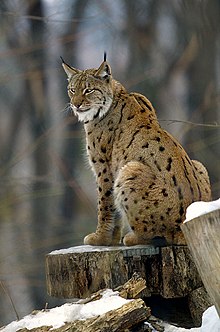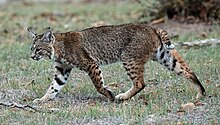Lynx
The name originated in Middle English via Latin from the Greek word lynx (λύγξ),[4] derived from the Indo-European root *leuk- ('light', 'brightness'), in reference to the luminescence of its reflective eyes.
[citation needed] Lynx have a short tail, characteristic tufts of black hair on the tips of their ears, large, padded paws for walking on snow and long whiskers on the face.
In colder northern climates lynx have thicker and lighter fur as well as larger and more padded paws that are well-adapted to snow.
[12] The Pliocene felid Felis rexroadensis from North America has been proposed as an even earlier ancestor; however, this was larger than any living species, and is not currently classified as a true lynx.
While its conservation status has been classified as "least concern", populations of Eurasian lynx have been reduced or extirpated from much of Europe, where it is now being reintroduced.
Fish and Wildlife Service designated the Canada lynx a threatened species in the lower 48 states.
[23] The Canada lynx is a good climber and swimmer; it constructs rough shelters under fallen trees or rock ledges.
With 13 recognized subspecies, the bobcat is common throughout southern Canada, the continental United States, and northern Mexico.
"[29] The bobcat is an adaptable predator that inhabits deciduous, coniferous, or mixed woodlands, but unlike other Lynx, does not depend exclusively on the deep forest, and ranges from swamps and desert lands to mountainous and agricultural areas, its spotted coat serving as camouflage.
Its coat is variable, though generally tan to grayish brown, with black streaks on the body and dark bars on the forelegs and tail.
The lynx inhabits high altitude forests with dense cover of shrubs, reeds, and tall grass.
The lynx was distributed throughout Japan during Jōmon period; with no paleontological evidence thereafter suggesting extinction at that time.
Since the 1990s, there have been numerous efforts to resettle the Eurasian lynx in Germany, and since 2000, a small population can now be found in the Harz mountains near Bad Lauterberg.
The lynx is found in the Białowieża Forest in northeastern Poland, and in the northern and western parts of China, particularly the Tibetan Plateau.
The Swedish population is estimated to be 1200–1500 individuals, spread all over the country, but more common in middle Sweden and in the mountain range.
[needs update] There is an Iberian lynx reproduction center outside Silves in the Algarve in southern Portugal.






